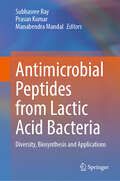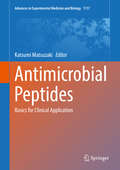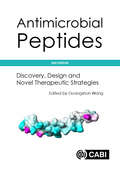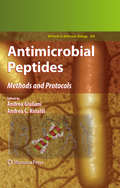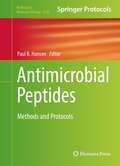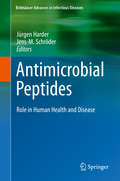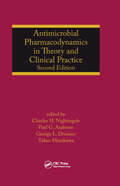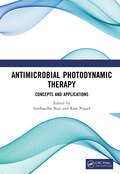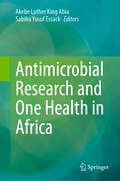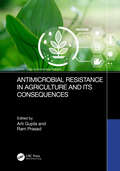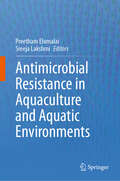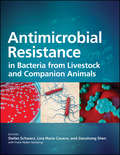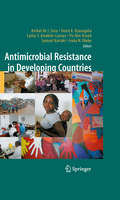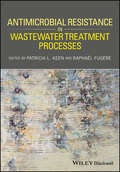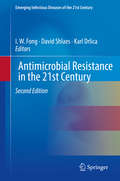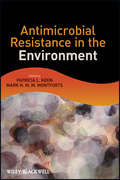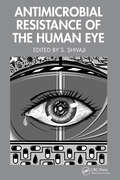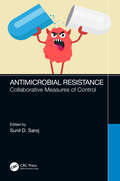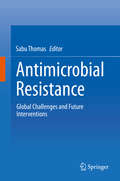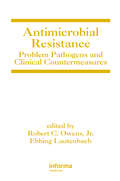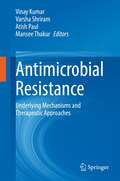- Table View
- List View
Antimicrobial Peptides from Lactic Acid Bacteria: Diversity, Biosynthesis and Applications
by Prasun Kumar Subhasree Ray Manabendra MandalAntimicrobial peptides (AMPs) have been sought to be a potential alternative to the current arsenal of antibiotics against undesirable microbes. AMPs synthesized by lactic acid bacteria have attracted significant attention due to their strong activity against a broad range of bacteria including pathogens. The bacteriocin (an AMP) has been known to us since early 1928, a year before penicillin was reported. This is possibly due to their narrower activity compared to antibiotics. However, several AMPs having promising activity have been thoroughly characterized in the past few decades. Renewed interest has developed focusing on industrially important bacteriocins produced by lactic acid bacteria. Some of these AMPs are also active against food spoilage and clinically important pathogens. Similar to antibiotics, large-scale intellectual screening is ongoing in the search for novel AMPs with unique properties. Recent research has revealed that AMPs may also play a role in maintaining gut microflora and keeping us protected from food-borne pathogens. The ongoing genomic studies suggest that there may be more such bioactive compounds waiting to be explored. This book provides an overview of the fundamental knowledge accumulated so far regarding the diversity and potential applications of AMPs produced by lactic acid bacteria. This updated reference book on AMPs from lactic acid bacteria is timely, covering the most important achievements in the field and providing the scientific community particularly graduate students, researchers, and clinicians with the latest updates. The goal of this book is to illustrate and detail the findings made so far, debate the state of the art, and draw new perspectives.
Antimicrobial Peptides: Basics For Clinical Application (Advances in Experimental Medicine and Biology #1117)
by Katsumi MatsuzakiThis book presents an overview of antimicrobial peptides (AMPs), their mechanisms of antimicrobial action, other activities, and various problems that must still be overcome regarding their clinical application. <P><P>Divided into four major parts, the book begins with a general overview of AMPs (Part I), and subsequently discusses the various mechanisms of antimicrobial action and methods for researching them (Part 2). It then addresses a range of activities other than antimicrobial action, such as cell penetration, antisepsis, anticancer, and immunomodulatory activities (Part 3), and explores the prospects of clinical application from various standpoints such as the selective toxicity, design, and discovery of AMPs (Part 4). <P><P>A huge number of AMPs have been discovered in plants, insects, and vertebrates including humans, and constitute host defense systems against invading pathogenic microorganisms. Consequently, many attempts have been made to utilize AMPs as antibiotics. <P><P>AMPs could help to solve the urgent problem of drug-resistant bacteria, and are also promising with regard to sepsis and cancer therapy. Gathering a wealth of information, this book will be a bible for all those seeking to develop antibiotics, anti-sepsis, or anticancer agents based on AMPs.
Antimicrobial Peptides: Discovery, Design and Novel Therapeutic Strategies
by Guangshun WangThis 18th in the series of Advances in Molecular and Cellular Microbiology, examines new technologies such as bioinformatics, combinatorial libraries, high-throughput screening, peptidomimetics, biophysics, and structural biology, in addition to covering the current advances in AMP research. This volume also describes new methods and strategies for AMP prediction, design, and applications that overcome obstacles in developing them into therapeutic agents.
Antimicrobial Peptides: Discovery, Design and Novel Therapeutic Strategies
by Guangshun WangAntimicrobial peptides (AMPs) have attracted extensive research attention worldwide. Harnessing and creating AMPs synthetically has the potential to help overcome increasing antibiotic resistance in many pathogens. This new edition lays the foundations for studying AMPs, including a discovery timeline, terminology, nomenclature and classifications. It covers current advances in AMP research and examines state-of-the-art technologies such as bioinformatics, combinatorial libraries, high-throughput screening, database-guided identification, genomics and proteomics-based prediction, and structure-based design of AMPs. Thoroughly updated and revised, this second edition contains new content covering: defensins; cathelicidins; anti-MRSA, antifungal, antiviral, anticancer and antibiofilm strategies; combined treatments; adjuvants in vaccines; advances in AMP technologies that cover surface coating to prevent biofilm formation; nanofiber encapsulation technologies for delivery and sustained release; and understanding innate immunity and the basis for immune boosting to overcome obstacles in developing AMPs into therapeutic agents. Written and reviewed by a group of established investigators in the field, Antimicrobial Peptides is a valuable resource for postgraduate students, researchers, educators, and medical and industrial personnel.
Antimicrobial Peptides: Discovery, Design and Novel Therapeutic Strategies (Advances In Molecular And Cellular Microbiology Ser.)
by Guangshun WangAntimicrobial peptides (AMPs) have attracted extensive research attention worldwide. Harnessing and creating AMPs synthetically has the potential to help overcome increasing antibiotic resistance in many pathogens. This new edition lays the foundations for studying AMPs, including a discovery timeline, terminology, nomenclature and classifications. It covers current advances in AMP research and examines state-of-the-art technologies such as bioinformatics, combinatorial libraries, high-throughput screening, database-guided identification, genomics and proteomics-based prediction, and structure-based design of AMPs. Thoroughly updated and revised, this second edition contains new content covering: defensins; cathelicidins; anti-MRSA, antifungal, antiviral, anticancer and antibiofilm strategies; combined treatments; adjuvants in vaccines; advances in AMP technologies that cover surface coating to prevent biofilm formation; nanofiber encapsulation technologies for delivery and sustained release; and understanding innate immunity and the basis for immune boosting to overcome obstacles in developing AMPs into therapeutic agents. Written and reviewed by a group of established investigators in the field, Antimicrobial Peptides is a valuable resource for postgraduate students, researchers, educators, and medical and industrial personnel.
Antimicrobial Peptides: Methods and Protocols (Methods in Molecular Biology #618)
by Andrea Giuliani Andrea C. RinaldiThe action of antimicrobial peptides (AMPs), ranging from direct killing of invading pathogens to immune response modulation and other complex biological responses, has stimulated research and clinical interest for more than two decades, but the area is still burgeoning due to emerging discoveries in the functions, roles, and regulation of AMPs, thus making the study of antimicrobial peptides a multi-disciplinary and rapidly evolving field. In Antimicrobial Peptides: Methods and Protocols, leading investigators present a broad, up-to-date collection of current research and experimental methods for the isolation, characterization, production, and optimization of antimicrobial peptides. Additional chapters detail methodologies in several microscopy techniques, high-throughput screening, QSAR modeling, and computer-aided design used to study these compounds, while key review articles survey potential medical applications of antimicrobial peptides as innovative anti-infective and immunomodulatory agents, as well as emerging discoveries in their function, regulation, and roles in innate immunity. As a volume in the highly successful Methods in Molecular BiologyTM series, chapters include introductions to their respective topics, lists of the necessary materials and reagents, step-by-step, readily reproducible laboratory protocols, and notes on troubleshooting and avoiding known pitfalls. Authoritative and wide-ranging in its applications, Antimicrobial Peptides: Methods and Protocols provides both an authoritative guide for lab work on AMPs or related substances and a useful collection of thought stimuli to inspire further scientific endeavours in a wide array of vital fields.
Antimicrobial Peptides: Methods and Protocols (Methods in Molecular Biology #Volumbe 1548)
by Paul R. HansenThis volume provides basic and advanced laboratory protocols for the non-specialist and the experienced researcher. Chapters are divided into three parts covering synthesis and characterization of AMPs, studying the interaction of AMPs with model systems or bacteria, and assaying selected biological activities of AMPs. <P><P>Written in the highly successful Methods in Molecular Biology series format, chapters include introductions to their respective topics, lists of the necessary materials and reagents, step-by-step, readily reproducible laboratory protocols, and tips on troubleshooting and avoiding known pitfalls.
Antimicrobial Peptides: Role in Human Health and Disease (Birkhäuser Advances in Infectious Diseases)
by Jürgen Harder Jens-M. SchröderThis book focuses on the importance of human antimicrobial peptides (AMP) in keeping the host healthy and preventing infectious diseases. The first chapters deal with several examples of the role of AMP in different epithelial organs (skin and wound healing, eye, lung, genito-urinary tract, gut), which are exposed to different kinds of infectious microorganisms and as a result produce different patterns of AMP. Examples of the dysregulation of AMP expression and function promoting infections are discussed. The capacity of AMP to restrict the availability of essential metals to bacteria as an efficient antibacterial strategy in nutritional immunity is discussed in the next chapter. Our current understanding of how vitamin D, the sunshine vitamin, influences AMP-expression and how this can affect our health is also addressed. Last but not least, the role of AMP in HIV infection and the immunomodulatory properties of AMP highlight the diverse facets of AMP in host immunity. AMP's specific functions, including in fighting multi-resistant bacteria, suggest that they may offer therapeutic benefits - a question that is discussed in the final chapter.
Antimicrobial Pharmacodynamics in Theory and Clinical Practice
by George L. Drusano Takeo Murakawa Charles H. NightingaleTaking readers from the research laboratory to the bedside, this Second Edition compiles essential information on the pharmacodynamics of all major classes of the antimicrobial armamentarium including penicillins, cephalosposorins, cephamycins, carbapenems, monobactams, aminoglycosides, quinolones, macrolides, antifungals, antivirals, and emerging
Antimicrobial Photodynamic Therapy: Concepts and Applications
by Ram Prasad Siddhardha BusiAntimicrobial Photodynamic Therapy: Concepts and Applications explores the novel antimicrobial therapeutic technique. As the world searches for new, efficient modalities for fighting microorganisms, this book offers a complete understanding of the concept, and knowledge about the emerging technique ‘antimicrobial photodynamic therapy’ (aPDT) for the scientific communities and budding researchers. The book aligns concepts, significance, and applications of the technique systematically. Chapters in the book cover microorganisms, pathogenesis, conventional treatment methods, and significance of new treatment approaches to the concept of antimicrobial photodynamic therapy. The authors describe the mechanism behind it, with applications and examples from research studies. The book discusses photosensitisers in detail, with one chapter emphasising natural photosensitisers. Use of nanostructures in the antimicrobial photodynamic therapy is elaborated on, and we conclude with a well-explored application of the therapeutic technique in dentistry. Features: Efficiently covers the topic in detail with scientifically proven examples. Applications of the therapeutic approach are well discussed, and readers can learn about the research gaps, challenges, and future of the technique. Starts from basics, enabling readers to understand why the approach is relevant and important for study. Simplistic elucidated concepts and applications make it accessible at all levels.
Antimicrobial Polymers
by Maria Jose Ocio Jose Maria Lagaron Amparo Lopez-RubioThe pioneering guide on the design, processing, and testing of antimicrobial plastic materials and coatingsThe manifestation of harmful microbes in plastic materials used in medical devices and drugs, water purification systems, hospital equipment, textiles, and food packaging pose alarming health threats to consumers by exposing them to many serious infectious diseases. As a result, high demand for intensifying efforts in the R&D of antimicrobial polymers has placed heavy reliance on both academia and industry to find viable solutions for producing safer plastic materials. To assist researchers and students in this endeavor, Antimicrobial Polymers explores coupling contaminant-deterring biocides and plastics--focusing particular attention on natural biocides and the nanofabrication of biocides. Each chapter is devoted to addressing a key technology employed to impart antimicrobial behavior to polymers, including chemical modification of the polymers themselves. A host of relevant topics, such as regulatory matters, human safety, and environmental risks are covered to help lend depth to the book's vital subject matter. In addition, Antimicrobial Polymers:Discusses the design, processing, and testing of antimicrobial plastic materialsCovers interdisciplinary areas of chemistry and microbiologyIncludes applications in food packaging, medical devices, nanotechnology, and coatingsDetails regulations from the U.S. (FDA and EPA) and EU as well as human safety and environmental concernsAchieving cleaner and more effective methods for improving the infection-fighting properties of versatile and necessary plastic materials is a goal that stretches across many scientific fields. Antimicrobial Polymers combines all of this information into one volume, exposing readers to preventive strategies that harbor vast potential for making exposure to polymeric products and surfaces a far less risky undertaking in the future.
Antimicrobial Research and One Health in Africa
by Akebe Luther King Abia Sabiha Yusuf EssackAntimicrobial resistance is recognised among the world’s most challenging problems. Despite its global spread, Africa, specifically sub-Saharan Africa, is the most affected by this malaise. Poor living conditions and inadequate access to sanitation and potable water supplies are among contributing factors that have influenced a high disease burden on the continent, requiring extensive antimicrobials. Weak health systems and the absence of firm policies further aggravate the problem, as the use of antimicrobials is mostly unregulated. The increasing demand for animal protein to meet the starving populations’ demands has also influenced the use of these antimicrobials, including those banned on other continents, for food animal production. The ripple effect of indiscriminate use in humans and animals is the massive discharge of antimicrobials, their residues, antimicrobial-resistant microorganisms and their associated genes into the environment. This 14-chapter unique masterpiece presents the AMR problem in African, addressing the various compartments of the One Health – humans, animals, and the environment, to illustrate the need for concerted efforts in the fight against AMR, especially in Africa. Authors from the four cardinal points present diverse aspects of AMR in Africa, starting with behavioural and social drivers of AMR in Africa. Antimicrobial stewardship in an African context is also discussed. AMR in humans is presented through studies on antibiotic-resistant neonates and nontyphoidal Salmonella infections and the clinical relevance of the genetics of viral resistance. Topics on AMR in mastitis, biosecurity in animal farming and the linkage between disinfectants and AMR are discussed. The environmental dimension of AMR is discussed, notably in the aquatic environment, and its implication for aquaculture and irrigation and using nanomaterials to treat polluted waters from such environments are highlighted. Finally, Africa’s rich floral diversity is portrayed as an eco-friendly and cost-effective approach to combat AMR. Hopefully, the work presented will spur greater collaboration between scientists, environmental, animal and human health practitioners, the general population, and policymakers to assimilate and implement the One Health approach to combating AMR, rather than working in silos on their various sectors
Antimicrobial Resistance in Agriculture and its Consequences (Current Trends in Antimicrobial Research)
by Ram Prasad Arti GuptaThis book offers comprehensive coverage of all manifestations of resistance in combating infectious diseases and explores advances in antimicrobial resistance in agriculture and their applications in the fight against microbes. It discusses and compares biological, biochemical, and structural aspects of resistance and its evolution. This is a comprehensive tool covering all manifestations of antimicrobial resistance and microbial resistance genes. In addition, it also provides a variety of photographs, diagrams, and tables to help illustrate the material. Novel strategies to combat antimicrobial resistance are also described, emphasizing collaborative measures of control. The underlining molecular mechanisms, which depend not only on the microbe but on the specific drug (target) molecule, are highly diverse and are covered in great detail.Students, researchers, scientists, practitioners, academics, computational biologists, stakeholders, and policymakers can benefit from using Antimicrobial Resistance in Agriculture and its Consequences as a resource that addresses microbial biotechnology, microbiology, ethnopharmacology, toxicology, medicinal plant products, and all disciplines related to antimicrobial research.Features of the book: Covers antimicrobial resistance in agriculture with up-to-date research Includes recent references on each plausible antimicrobial resistance in agriculture Details the possible spread of antibiotic resistance bacteria from animals to humans Provides several perspectives in the resistance flux with modern agricultural practices Describes the public health impact of the use of antibiotics in agriculture Presents cutting-edge research on epigenetics, nanotechnology, and emergent antimicrobial technologies Outlines recent laws and regulatory guidelines in the federal agency, responsibility, and authority
Antimicrobial Resistance in Aquaculture and Aquatic Environments
by Preetham Elumalai Sreeja LakshmiThis book provides the latest information on aquatic AMR from the perspective of inflammation and presents new ideas on the complicated mechanisms of lectin biochemistry and associated interactions. Key features include discussion of mechanisms recently identified to be involving surveillance and monitoring of AMR and AMU, presentation of the latest evidence regarding the molecular approaches in disease therapeutics, and thorough explanation of the concept of one health challenges and current understanding of the significance of its disease resistance related studies. Gene expression studies is another important element of the book, and it is proposed that gene editing technology provides gaining attention in the biological role of fresh water and marine environments. Examples of the many latest molecular approaches, applications and future perspectives in AMR specific topics covered in this book include the information right from the basics to the advancements in this area. The book will be a valuable update and resource for both experienced and younger researchers working in the field of marine biology and immunology.
Antimicrobial Resistance in Bacteria from Livestock and Companion Animals (ASM Books)
by Stefan Schwarz Jianzhong Shen Lina CavacoThe global spread of antimicrobial-resistant pathogenic bacteria is a continuing challenge to the health care of humans and domesticated animals. With no new agents on the horizon, it is imperative to use antimicrobial agents wisely to preserve their future efficacy. Led by Editors Stefan Schwarz, Lina Maria Cavaco, and Jianzhong Shen with Frank Møller Aarestrup, an international team of experts in antimicrobial resistance of livestock and companion animals has created this valuable reference for veterinary students and practitioners as well as researchers and decision makers interested in understanding and preventing antimicrobial resistance.
Antimicrobial Resistance in Developing Countries
by Samuel Kariuki Carlos F. Amábile-Cuevas Po-Ren Hsueh Iruka N. Okeke Denis K. Byarugaba Aníbal De SosaToday, there is considerable literature regarding the subject of antimicrobial resistance. However, most of this information is based on information from developed countries. Very little organized information is available about the subject that critically examines the problem in developing countries. Scattered literature is available in various forms in journals that are often not easily accessible to the affected developing countries. The objective of the book is to put together data and information about the problem of antimicrobial resistance in developing countries addressing the general global perspectives, the risk factors, the current rates, trends, and possibilities for containment as they relate to specific conditions in those developing countries.
Antimicrobial Resistance in Wastewater Treatment Processes
by Patricia L. Keen Raphaël FugèreAntimicrobial resistance is arguably the greatest threat to worldwide human health. This book evaluates the roles of human water use, treatment and conservation in the development and spread of antimicrobial resistance. Designed as a companion volume to Antimicrobial Resistance in the Environment (Wiley-Blackwell, 2012), this book is a multi-disciplinary synthesis of topics related to antimicrobial resistance and wastewater treatment processes. Antimicrobial Resistance in Wastewater Treatment Processes assembles detailed discussions written by many of the world's best-known experts in microbiology, civil engineering, chemistry, environmental science, public health and related fields. The book presents a collection of subjects that includes: Current knowledge of the role of the environment in development and spread of antimicrobial resistance Chemical analysis of antibiotics in environmental samples Molecular methods for analysis of antimicrobial resistance genes Advanced wastewater treatment processes and antimicrobial resistance effects Public perception of risk related to health consequences of antimicrobial resistance Public health implications of antimicrobial resistance with focus on wastewater treatment processes Antimicrobial resistance has gained a foothold in the global consciousness as a serious public health threat. There is a much greater appreciation for the role of the environment in the dissemination of antimicrobial resistance and the effects of pollutants that can potentially promote development of resistance in bacteria. Contaminants released from wastewater treatment plants are a concern. In Antimicrobial Resistance in Wastewater Treatment Processes, readers will be guided through examinations of the current science related to this important health issue.
Antimicrobial Resistance in the 21st Century (Emerging Infectious Diseases of the 21st Century)
by I. W. Fong David Shlaes Karl DrlicaThis comprehensive, up-to-date volume defines the issues and offers potential solutions to the challenges of antimicrobial resistance. The chapter authors are leading international experts on antimicrobial resistance among a variety of bacteria, viruses including HIV and herpes, parasites and fungi. The chapters explore the molecular mechanisms of drug resistance, the immunology and epidemiology of resistance strains, clinical implications and implications on research and lack thereof, and prevention and future directions.
Antimicrobial Resistance in the Environment
by Patricia L. Keen Mark H. MontfortsExamines effects of the environmental distribution of antimicrobial resistance genes on human health and the ecosystem Resistance genes are everywhere in nature—in pathogens, commensals, and environmental microorganisms. This contributed work shows how the environment plays a pivotal role in the development of antimicrobial resistance traits in bacteria and the distribution of resistant microbial species, resistant genetic material, and antibiotic compounds. Readers will discover the impact of the distribution in the environment of antimicrobial resistance genes and antibiotics on both the ecosystem and human and animal health. Antimicrobial Resistance in the Environment is divided into four parts: Part I, Sources, including ecological and clinical consequences of antibiotic resistance by environmental microbes Part II, Fate, including strategies to assess and minimize the biological risk of antibiotic resistance in the environment Part III, Antimicrobial Substances and Resistance, including antibiotics in the aquatic environment Part IV, Effects and Risks, including the effect of antimicrobials used for non-human purposes on human health Recognizing the intricate links among overlapping complex systems, this book examines antimicrobial resistance using a comprehensive ecosystem approach. Moreover, the book's multidisciplinary framework applies principles of microbiology, environmental toxicology, and chemistry to assess the human and ecological risks associated with exposure to antibiotics or antibiotic resistance genes that are environmental contaminants. Each chapter has been written by one or more leading researchers in such fields as microbiology, environmental science, ecology, and toxicology. Comprehensive reference lists at the end of all chapters serve as a gateway to the primary research in the field. Presenting and analyzing the latest findings in a field of growing importance to human and environmental health, this text offers readers new insights into the role of the environment in antimicrobial resistance development, the dissemination of antimicrobial resistant genetic elements, and the transport of antibiotic resistance genes and antibiotics.
Antimicrobial Resistance of the Human Eye
by S. ShivajiThe book covers antimicrobial resistance in ocular diseases, including the microbiology of the ocular surface, the history and origin of antimicrobials, methods to detect antimicrobial resistance and antimicrobial resistance genes, and the impact of antimicrobial resistance on a variety of ocular diseases. The inclusion of chapters covers bacterial keratitis, fungal keratitis, viral keratitis, acanthamoeba keratitis, endophthalmitis, dry eye disease, post fever retinitis, and uveitis including management and prevention of antimicrobial resistance.Key Features: Focusses on various ocular diseases and their association with antimicrobial resistance; Includes data relevant to drug industry to develop drugs for specific ophthalmic use; Illustrates ocular surface microbiome under various diseased condition;s Highlights the microbes associated with the conjunctiva and cornea of the human eye; Enumerates the changes in the abundance and diversity of the antimicrobial resistant (AMR) microorganisms in the diseased eye. This book is aimed at professionals and researchers in ophthalmology, microbiologists, infectious disease specialists, and public health.
Antimicrobial Resistance: Collaborative Measures of Control
by Sunil D. SarojAntimicrobial resistance has existed in nature long before the discovery of antibiotics. The mechanisms of resistance are prevalent among the bacterial population. Over a period of time and facilitated by indiscriminate usage of antibiotics, these mechanisms are transferred from one type of bacteria to another, including the pathogenic ones. In addition, the rate of discovery of novel antimicrobials is much slower than the rate of evolution of antimicrobial resistance. Therefore, there is a need for alternative strategies to control antimicrobial resistance to save lives. In this book, the novel strategies to combat antimicrobial resistance are described, emphasizing collaborative measures of control. We describe the concerted efforts undertaken by global communities to combat antimicrobial resistance in detail. The most efficient strategy could be a behavioral change towards indiscriminate consumption, usage, and prescription of antibiotics.
Antimicrobial Resistance: Global Challenges and Future Interventions
by Sabu ThomasAntimicrobial resistance is a major global public health problem. This book focuses on the clinical implications of multi-drug resistant pathogens; tracking AMR and its evolutionary significance; antifungal resistance; and current and alternative treatment strategies for AMR, including antivirulent, antibiofilm and antimicrobial resistance breakers, repurposing of drugs, and probiotic therapy. Advances in antimicrobial stewardship, antibiotic policies from a global perspective and their impacts are also discussed. The book also explores the use of omics approaches to gain insights into antibacterial resistance, and includes chapters on the potential benefits of a ‘One Health approach’ describing the environmental and zoonotic sources of resistant genes and their effects on the global resistance pool.
Antimicrobial Resistance: Omics and Systems Biology Approaches
by Vijay Soni Ajay Suresh AkhadeAntimicrobial resistance (AMR) is increasing globally at an incredible rate, and many infectious diseases have already reached an alarming stage of resistance to existing treatments. WHO reports that nearly1.27 million people currently die each year due to resistant infections, and AMR is projected to account for 10 million annual deaths globally by 2050. There is an urgent need for novel approaches to address this issue. Omics technologies are powerful research tools used extensively to study pathogen biology and the activity of microbial agents. These tools, paired with systems biology approaches, can provide novel insights into antimicrobial susceptibility and resistance, and aid in the development of new, more effective measures to combat resistant pathogens. This book provides a comprehensive overview of omics technologies to study pathogen biology, including proteomics, genomics, transcriptomics, metabolomics, and microbiome analysis, and the role of systems biology in developing strategies to combat resistant pathogens. It addresses environmental reservoirs and mobile genetic agents in AMR, host-pathogen interactions and physiology in the development of resistance, drug repurposing and development, and cutting-edge tools such as machine learning, AI for big data analysis, and genomic surveillance. The final section discusses future perspectives on omics-systems biology in AMR, and identifies opportunities for scientific collaboration in the global fight against antimicrobial resistance. This book serves as a comprehensive and accessible resource for researchers in academia and industry focused on immunology, drug development, biotechnology, and systems biology.
Antimicrobial Resistance: Problem Pathogens and Clinical Countermeasures (Infectious Disease And Therapy Ser. #Vol. 48)
by Jr. Ebbing Lautenbach Robert C. OwensThis publication provides a state-of-the-art overview of key issues related to antimicrobial resistance, including a focus on key pathogens causing common healthcare-associated and community-acquired infections. The epidemiology and therapeutic considerations of these antimicrobial resistant organisms are discussed, as well as the clinical and heal
Antimicrobial Resistance: Underlying Mechanisms and Therapeutic Approaches
by Vinay Kumar Varsha Shriram Atish Paul Mansee ThakurAntimicrobial resistance (AMR) is a global public health threat that needs immediate attention and action from the scientific community. This book compiles and presents the latest and most important aspects of AMR, including the biology involved, its persistence and spread, and novel approaches to tackle this threat. The book first describes the mechanisms and spread of AMR, and then discusses the various approaches and strategies for combating it. Important topics include, microbial pathogenesis, AMR traits and major mechanisms underlying drug-resistance and the emerging strategies and technologies for combating AMR. Emphasis has been given on current developments about natural products including potent phyto-molecules, antimicrobial peptides and endophytes effective against the drug-resistant microbes and target the main drug-resistance determinants (efflux pumps, biofilms, quorum sensing, plasmids, etc.) in these bacterial pathogens. Other exciting topics include applications of nanomaterials in tackling AMR and CRISPR-Cas based precise sequence-specific antimicrobials. This informative book is meant for students and researchers in basic and medical microbiology and biotechnology. It is also useful to public health professionals and industry experts involved in AMR research and related drug-designing.
